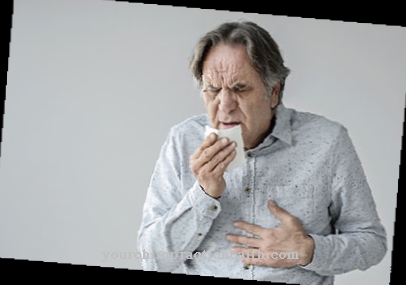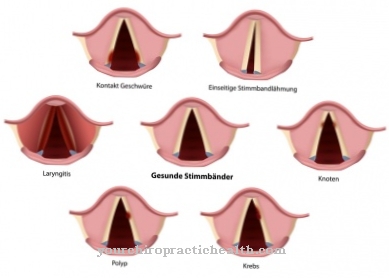The Osteoonychodysplasia is a mutation-related malformation syndrome with predominant involvement of the limbs. In addition to skeletal abnormalities, kidney and eye involvement is common. The primary goal of symptomatic treatment is to delay end-stage renal failure.
What is osteoonychodysplasia?

© inegvin - stock.adobe.com
Malformation syndromes are characterized by the dysplasia of various structures of the anatomy. In medicine, dysplasia is the malformation of tissues or organs. Dysplastic manifestations are, for example, underdeveloped or overdeveloped. The Osteoonychodysplasia is a congenital malformation syndrome with predominant involvement of the extremities. It is associated with various malformations and functional disorders of various organs.
A well-known disease from this group is, for example, the nail-patella syndrome, which is associated with deformities of the fingernails and the bones. As a subgroup of osteoonchyodysplasias, the nail-patella syndrome occurs in around one case in 50,000 newborns around the world. Girls are affected just as often as boys. The age of manifestation is considered to be toddler age.
Osteoonychodysplasia is also called Turner-Kieser Syndrome and is associated with heredity. The hereditary disease was first documented in the 20s to 30s. The American Turner, the German Kieser and the Austrians Trauner and Rieger are considered to be the first to describe it.
causes
Osteoonychodysplasia is a hereditary disease. The symptom complex is inherited in an autosomal dominant mode of inheritance. The agreements of a sick parent therefore fall ill with a 50 percent risk of the malformation syndrome. In most cases, therefore, familial accumulation was observed. However, sporadic cases have also been observed.
The primary cause for both variants is a genetic mutation, which corresponds to a new mutation if it occurs sporadically. The mutation apparently affects the LMX1B gene on the longer arm of chromosome 9. The gene locus is 9q34. The previous studies on osteoonychodysplasia suggest more than 80 different mutations of the same gene as the cause of the disease. The LMX1B gene is a transcription factor for the extremities that comes from the group of LIM homeodomain proteins.
These proteins are involved in the development of the extremities as well as in kidney and eye development. Depending on the involvement of the kidneys, the nail-patella syndrome is causally associated with different alleles. A mutation of the LMX1B gene leads to a loss of function of the transcription factor, so that development is impaired. The disease is associated with the AB0 system of blood groups.
Symptoms, ailments & signs
Osteoonychodysplasia patients suffer from deformed skeletal structures with conduction symptoms. The malformations of their bones and joints appear in the X-ray mainly as an underdeveloped patella. There is often a bony exostosis on the right iliac crest or the posterior horn of the pelvis. Patella involvement affects more than 90 percent of patients.
A complete failure of the structure occurs in almost a quarter of all cases. The underdeveloped and partially dislocated patella makes the knees of the patient partially unstable, so that motor development is delayed and falls are more likely. The elbows can only bring the patient to pronation or supination to a limited extent. The head of the spoke is often subluxated. In the majority of all cases, the disease is associated with arthrodysplasia of the elbows.
The limb joints are usually capable of hyperextension. Other case reports have documented bone changes such as scoliosis, neck rib attachment, and underdevelopment of the nails for the syndrome. In individual cases, these symptoms can be associated with kidney problems, which can trigger proteinuria or nephritis.
Other accompanying symptoms can be hypothyroidism, irritable bowel syndrome, attention deficit disorder or thin tooth enamel. Eye symptoms and sensory-neural hearing loss often round off the symptomatic picture.
Diagnosis & course of disease
The doctor makes the first suspected diagnosis of osteoonychodysplasia via x-ray imaging, which shows the characteristic changes in the skeleton. Characteristic changes in the glomerular basement membrane can also often be detected by electron optics.
A molecular genetic analysis is not necessary in most cases, as the typical clinical picture alone corroborates the first suspected diagnosis. The patient's prognosis depends on the severity of the individual case. If the organs are heavily involved, the syndrome can be fatal.
Complications
Since osteoonychodysplasia is a complex of symptoms of various hereditary diseases, the risk of complications for the affected patients is different. The life expectancy in the so-called nail-patella syndrome, which is characterized by deformations of the fingernails and bones, is not reduced. Internal organs are often involved in the other forms of osteoonychodysplasia.
Over 50 percent of patients suffer from kidney failure. The course of kidney disease in particular determines the prognosis of the disease. Often the renal failure progresses and leads to the fact that the patient becomes on dialysis. In these cases, curative therapy is only possible with a kidney transplant. This is especially true if there is a risk of total failure of both kidneys.
Other complications in osteoonychodysplasia are scolioses, club feet, exotic diseases (overlegs) or deformed elbow joints. In these cases, orthopedic treatments are necessary. Sometimes cardiac arrhythmias or glaucoma occur as complications. The prognosis of cardiac arrhythmias varies from person to person.
To avoid long-term heart disease, getting treatment from a cardiologist is important. In glaucoma, blindness can occur later if the intraocular pressure is not reduced. The deformation of the bones and fingernails themselves can have psychological effects on the patient if his appearance gives him the feeling of being socially excluded.
When should you go to the doctor?
If visual irregularities or malformations of the skeletal system are noticed immediately after birth, a health check should take place immediately. If the birth takes place with an obstetrician team, the parents normally do not have to take any further action. Midwives and doctors independently record the infant's state of health and document abnormalities. Imaging and other examinations determine all deviations and a diagnosis is made.
If there are deviations in health, delays or underdevelopment in the further development and growth process, the observations should be discussed with a doctor. A doctor is required in the event of hearing loss, the possibility of overstretching the joints or an optical flaw in the nail shape.
Often an abnormal sequence of movements takes place in everyday life, which can be interpreted as an indication of a disease. A doctor should be presented with thin enamel, impaired attention, or poor physical and mental resilience. Irregular urination or kidney function must also be examined and treated by a doctor.
If deficiency symptoms appear despite an adequate and balanced diet, this can be a warning signal for the organism. A check-up visit to a doctor is necessary so that the cause of the symptoms can be found. Disturbances of the elbow activity and visual changes in the joint are noticeable in osteoonychodysplasia.
Treatment & Therapy
A causal treatment is currently not available for patients with osteoonychodysplasia. The disease cannot be cured as long as gene therapy approaches do not reach the clinical phase. Gene therapy may turn the complex of symptoms into a curable disease in the future, but at this point in time patients are treated solely symptomatically.
If the kidneys are involved, the treatment of proteinuria is the focus of therapy. This symptom can result in kidney failure. Therefore a reduction in proteinuria must be aimed for in the treatment of nephropathy. Most patients still develop kidney failure around the age of 30. A kidney transplant is the treatment of choice at this stage.
The skeletal dysplasias of osteoonychodysplasia can also be corrected with reconstructive operations. This applies, for example, to a failure of the patella. Physiotherapy may be required to stabilize the skeleton. The targeted building of muscles gives the mostly hypoplastic bones and joints support.
In addition, physiotherapy promotes normal motor development. Symptoms like nail hypoplasia are more of a cosmetic problem and do not necessarily need to be corrected immediately. If treatment of the nail hypoplasia is nevertheless desired, a nail bed transplant usually takes place.
Outlook & forecast
As a rule, it is recommended to consult a doctor as soon as the first symptoms of osteoonychodysplasia appear, as this can favor the further course of the disease. Since there is no cure for this genetic disease, those affected are dependent on purely symptomatic treatment aimed at reducing proteinuria and thus delaying terminal kidney failure.
It is particularly important to strictly follow the doctor's instructions. This usually includes taking diuretics and corticosteroids, avoiding alcohol consumption, regular monitoring of kidney function, a balanced diet and a healthy lifestyle. Attending physiotherapy with accompanying exercises at home is also advisable, as the skeleton and motor skills can benefit from stronger muscles and thus the course of the disease can be positively influenced.
If all of these medical recommendations are followed consistently, the time of kidney failure can be postponed to the maximum age of 30 in a third of patients. Since patients very often feel left out due to their clearly visible deformations, psychotherapeutic treatment or visiting self-help groups can be of great help to improve the quality of life.
Often, however, the patient's life expectancy is significantly reduced due to kidney failure. This can only be counteracted by a kidney transplant as a final treatment option, which is usually carried out shortly before the age of 30. This can completely rule out the disease flaring up again in the transplant and thus offer a very good prospect of future living conditions. If the patient wishes to have children, genetic tests and counseling would be recommended, which can rule out the inherited occurrence of the disease.
prevention
Osteoonychodysplasia can only be prevented in the form of genetic counseling in the family planning phase.
Aftercare
In most cases, the person affected with osteoonychodysplasia has no special or direct follow-up measures available, so that the person affected should definitely consult a doctor very early on in this disease. The earlier a doctor is consulted, the better the further course of the disease will usually be. A doctor should therefore be contacted at the first signs and symptoms.
Since this is a genetic disease, if you want to have children, you should definitely have a genetic test and counseling carried out to prevent the disease from recurring. Most of those affected are dependent on a permanent examination of the kidney.
Drinking alcohol should also be avoided if possible. In general, a healthy lifestyle with a balanced diet has a positive effect on the further course of the disease. Furthermore, physiotherapy measures are also very important, whereby the person affected can also perform many of the exercises in their own home.However, it is not uncommon for osteoonychodysplasia to reduce the life expectancy of those affected, as it often leads to kidney failure.
You can do that yourself
There is no cure for osteoonychodysplasia, but certain methods can be used to alleviate its negative effects. In symptomatic therapy, it is important to strictly adhere to the doctor's recommendations. Treatment includes taking corticosteroids and diuretics regularly. Depending on the severity of the genetic defect, dialysis therapy is often available as early as infancy.
A lot of patience is required, especially in severe cases with malformations of the spine or extremities. With assistance in everyday life, the problems with locomotion and various activities can be reduced. If the foot is deformed, special insoles or shoes are used to make it easier for those affected. If the pelvic bone is also damaged, further relief measures may be necessary.
The psychological consequences for the patient play a very important role. They often feel left out, especially if they have clearly visible malformations. Attending self-help groups is recommended for a better quality of life. In the family, too, it makes sense to talk about the problem and look for practical solutions.
A special diet can help with kidney failure. In addition, the skeleton is strengthened by stronger muscles. With regular physiotherapy, the body gets more strength, and motor skills develop normally.



.jpg)

.jpg)







.jpg)

.jpg)
.jpg)











.jpg)